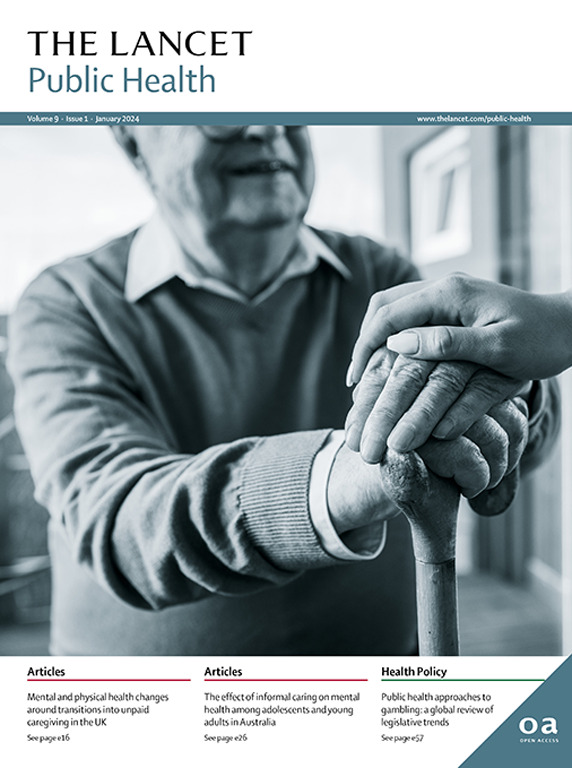National roll-out of social prescribing in England's primary care system: a longitudinal observational study using Clinical Practice Research Datalink data
IF 25.2
1区 医学
Q1 PUBLIC, ENVIRONMENTAL & OCCUPATIONAL HEALTH
引用次数: 0
Abstract
Background
Social prescribing is growing rapidly in England and across the world. However, it remains unclear who it is reaching and how effectively it is being implemented. This study aimed to assess longitudinal trends in social prescribing in England's primary care system, including growth trajectories and target alignment, sociodemographic profiles of referred patients, and predictors of service refusal over time.Methods
This nationwide, longitudinal observational study analysed primary care records from 1·2 million patients from 1736 general practitioner (GP) practices in the Clinical Practice Research Datalink in England. We estimated social prescribing trends between 2019 and 2023 using growth curve modelling on social prescribing numbers at the practice level. Descriptive analyses were used to show changes in sociodemographic profiles of social prescribing patients over time. To assess sociodemographic disparities in service refusal (defined as having a medical code of social prescribing declined), we used multilevel logistic regression models stratified by year, accounting for nested data structure where patients were nested within practices.Findings
As of the end of 2023, an estimated 9·4 million GP consultations in England have involved social prescribing codes, and 5·5 million consultations have specifically led to social prescribing referrals. In 2023 alone, an estimated 1·3 million patients were referred to social prescribing. 60% of patients offered social prescribing were female and 23% were from ethnic minority groups. Representation from patients living in more deprived areas increased from 23% to 42% between 2017 and 2023. Service refusal declined from 22% to 12% between 2019 and 2023. Age, sex, and ethnicity were associated with service refusal across multiple years. Notably, in 2023, all age groups had higher odds of refusal compared with the youngest age group. Female patients had 21% (95% CI 0·77–0·82) lower odds of refusal than males, and patients from White ethnic backgrounds had 32% (1·26–1·39) higher odds of refusal than ethnic minority patients.Interpretation
Social prescribing has expanded rapidly in England, far exceeding initial targets of 900 000 patients by 2023–24, suggesting broad service acceptability. Progress is being made in reaching specific target groups, such as more deprived communities. However, there are still disparities in accessibility and uptake, calling for targeted strategies to address underlying inequalities.Funding
MQ Transforming Mental Health, Rosetrees-Stoneygate Trust Fellowship, National Academy for Social Prescribing.英国初级保健系统中社会处方的全国推广:使用临床实践研究数据链数据的纵向观察研究
社会处方在英国和世界各地都在迅速增长。然而,目前尚不清楚它的目标是谁,以及它的执行效果如何。本研究旨在评估英国初级保健系统中社会处方的纵向趋势,包括增长轨迹和目标一致性,转诊患者的社会人口学概况,以及随着时间的推移拒绝服务的预测因素。方法:这项全国性的纵向观察性研究分析了英国临床实践研究数据链中来自1736名全科医生(GP)实践的120万名患者的初级保健记录。我们在实践层面使用社会处方数量的增长曲线模型估计了2019年至2023年的社会处方趋势。描述性分析用于显示社会处方患者的社会人口学特征随时间的变化。为了评估拒绝服务的社会人口差异(定义为有社会处方下降的医疗代码),我们使用了按年分层的多层次逻辑回归模型,考虑了嵌套的数据结构,其中患者嵌套在实践中。研究结果显示,截至2023年底,英格兰估计有940万次全科医生咨询涉及社会处方代码,550万次咨询专门涉及社会处方转诊。仅在2023年,估计就有130万患者转诊到社会处方。提供社会处方的患者中,女性占60%,少数民族占23%。2017年至2023年间,生活在更贫困地区的患者比例从23%增加到42%。2019年至2023年间,服务拒绝率从22%下降到12%。年龄、性别和种族与多年拒绝服务有关。值得注意的是,在2023年,与最年轻的年龄组相比,所有年龄组的拒绝率都更高。女性患者的拒绝率比男性低21% (95% CI 0.77 ~ 0.82),白人患者的拒绝率比少数民族患者高32%(1.26 ~ 1.39)。社会处方在英格兰迅速扩张,到2023-24年远远超过最初的目标90万患者,这表明广泛的服务可接受性。在接触特定目标群体,例如较为贫困的社区方面正在取得进展。然而,在可及性和吸收方面仍然存在差距,需要制定有针对性的战略来解决潜在的不平等现象。资金mq转变心理健康,rosetree - stoneygate信托奖学金,国家社会处方学会。
本文章由计算机程序翻译,如有差异,请以英文原文为准。
求助全文
约1分钟内获得全文
求助全文
来源期刊

Lancet Public Health
Medicine-Public Health, Environmental and Occupational Health
CiteScore
55.60
自引率
0.80%
发文量
305
审稿时长
8 weeks
期刊介绍:
The Lancet Public Health is committed to tackling the most pressing issues across all aspects of public health. We have a strong commitment to using science to improve health equity and social justice. In line with the values and vision of The Lancet, we take a broad and inclusive approach to public health and are interested in interdisciplinary research.
We publish a range of content types that can advance public health policies and outcomes. These include Articles, Review, Comment, and Correspondence. Learn more about the types of papers we publish.
 求助内容:
求助内容: 应助结果提醒方式:
应助结果提醒方式:


